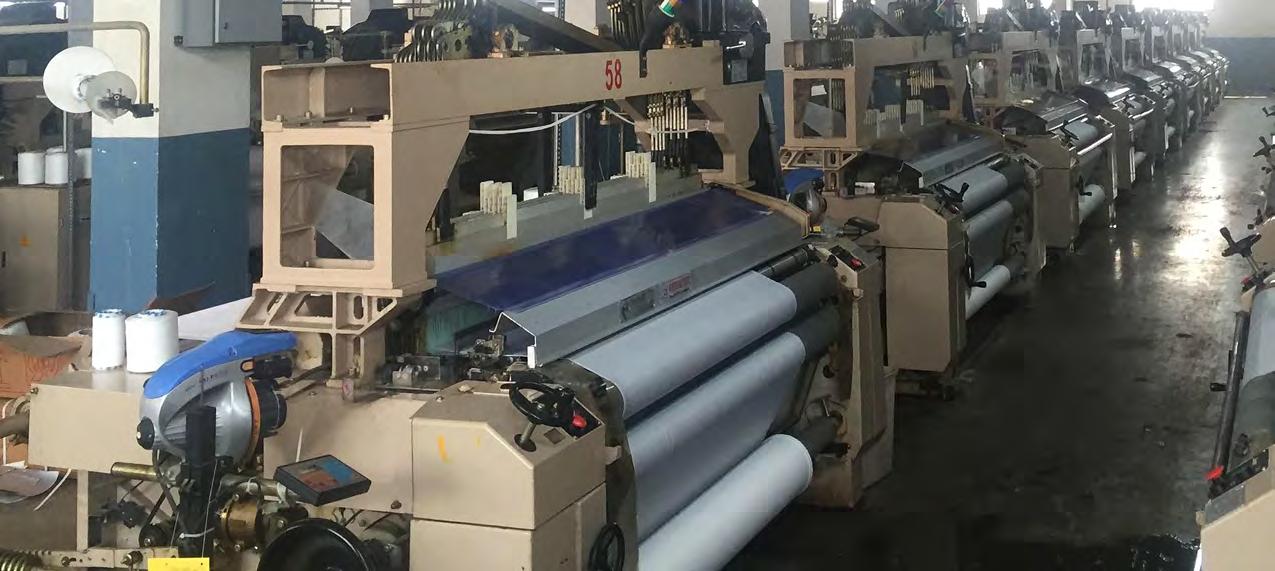
8 minute read
How Samin Textiles became Waves Home Appliances
How Samin Textiles
became Waves Home Appliances
Advertisement
Pakistani corporations are looking for alternatives to Initial Public Offerings
By Saad Tanvir
From a textile manufacturer to a home appliances distributor. Waves has managed to convert a dormant, going concern, listed company into an active home appliances distributor and is eyeing to mold it into a large-scale retail organization with its own home appliances manufacturing unit.
As per a recent notification posted on the PSX, Waves Singer Pakistan has demerged its home appliances manufacturing division and merged it into Samin Textile, which would now be renamed to Waves home appliances. The notification presented that the principal line of business would be changed to include manufacturing & assembly, alongside wholesale of home appliances & other light engineering products.
Samin textiles, a quiescent listed company on the PSX, had caught the attention of a large conglomerate - Waves Singer Pakistan Limited. Mr. Haroon Ahmed, the CEO and majority shareholder at Waves singer Pakistan, had increasingly shown interest in the acquisition of the bleeding Samin textile at the beginning of last year. He managed to present a revival plan for its transformation and successfully went on to acquire the textile company. The Sale Purchase Agreement was originally signed in January 2021 between the sponsors and Mr. Haroon, constituting a consideration of Rs. 25 million against 67.1% ownership of the company.
There, Haroon saw an opportunity to carve out a separate business segment for his expanding company, Waves Singer. The business of Waves was to be transferred to Samin, which included its manufacturing and retail business, while waves itself would venture into the real estate business. A great strategy, but why pay Rs. 25 million for it? Why not just create a privately listed entity? or a listed one for that matter. Why did waves acquire an already listed company with essentially no real balance sheet? No assets, only liabilities. Since Waves had planned to completely restructure a textiles manufacturing and distribution company into a home appliances business, were its dealership network, brand name, customer base, or supply chain of any use? Other than it’s Tangible assets – which Waves had not acquired, what benefit could Samin textiles yield for waves? There was seemingly no synergy at all.
A bit about Samin Textiles
Samin Textiles Limited (SMTM) was incorporated in Pakistan in November 1989 and was listed on the PSX in 1994. The principal business of the company used to be manufacturing and sale of textile products. The company had its registered office at Main Gulberg, Lahore, while the plant used to be situated at Manga Raiwind Road, Kasur. Historically, the company had been afloat for quite some time, but the last 10 years proved to be fatal for its survival. It experienced its first blow in 2012 when its sales declined drastically from Rs. 3,096 million in 2011 to Rs. 2,435 million in 2012. The company then managed to keep them stable around the Rs. 2,500 million mark for the next 2 years, but in 2015 eventually witnessed a decay in its sales which continued to haunt it, until its ultimate shut-down in 2018. The company had experienced substantial losses during its last couple of years, including a loss of Rs. 283 million in 2017, and a colossal Rs. 898 million in 2018.
What happened?
As per the official statement given by the company itself in a notification, the company ceased its operations in September 2018, subject to massive losses & piling up of substantial liabilities pertaining to: sluggish textile demand in the international market; obsolescence of the existing plant and machinery; lack of investment from sponsors; and the non-availability of viable orders. This led to the ultimate demise of the textile mill, as the board of directors were forced to liquidate the company’s assets in order to clear-off its burgeoning debt obligations.
Although, upon liquidation, an alternative business plan was drawn out, the company never managed to set its foot back in the game. The plan suggested to convert the company’s core line of business to trading, importing & exporting of textiles rather than manufacturing. This, however, miserably failed and the company incurred a loss of Rs. 36.3 million in 2019. Subsequently, the board of directors announced that due to high energy costs, deteriorating condition of the textile sector and high taxes, it was not viable to implement the business plan and the idea was dissolved. Ever since, the company conducted multiple feasibilities to venture into different businesses, but never managed to gain any success and has been predominantly considered dormant until the start of this fiscal year when the revival plan presented by waves came into play.
Why go for acquisition
Considering that Samin textiles had liquidated long before Haroon decided to present them with an offer, what exactly was he or Waves interested in? Why would they buy a listed company with zero assets? Well, what waves was buying was nothing more than the listed status of the company. But why? “In order to carve out the appliances business and make it part of a dedicated & independent company, whose shares are also listed on the stock exchange, we used Samin textiles.” – Mr. Haroon Ahmed Khan Profit asked Haroon why Waves would not create its own subsidiary and list it on the stock exchange rather than acquire a dormant listed entity thereby paying a hefty cost. Haroon emphasized if waves had created a separate private limited company for its manufacturing segment and later went on to list it, it may have taken a few years. However, if he bought an already listed company, which had no business or assets, he could rather mitigate that time and carve out his manufacturing segment into that listed company in a much more efficient manner. This raises the question: Haroon paid essentially Rs. 25 million to get his foot in the door right away rather than wait a few years and maybe save a few millions. Why did he do that?
Listing enables the company to showcase its growth, performance and market value to the general public, attract further investments from both High-net-worth individuals (HNWI) or retail investors, and increase its market capitalization. Listing provides free publicity and outreach, indirectly benefiting the core operations of the organization, it enhances the company’s public perception and a more credible image
Benefits of listed corporations
Listed companies often enjoy certain benefits that unlisted or private limited corporations do not. For starters, the platform for a listed company is very useful for the management to raise equity for expansionary projects in case needed and pursue growth opportunities as compared to a non-listed entity. It opens up doors for investors to directly participate in the entity rather than take the indirect route via the holding company i.e if an investor wants to directly acquire a stake in the appliances business rather than the other business segments of the holding company, he could easily do so. Listing enables the company to showcase its growth, performance and market value to the general public, attract further investments from both Highnet-worth individuals (HNWI) or retail investors, and increase its market capitalization. Listing provides free publicity and outreach, indirectly benefiting the core operations of the organization, it enhances the company’s public perception and a more credible image. Listing can also help attract the best talent, enhance the company’s relationship with its current & potential customers and suppliers, increase the opportunities for partnering with local and international companies, and strengthen employee commitment via share ownership schemes. For these benefits Haroon wanted waves’ manufacturing company to be listed on the PSX, acting as a separate legal entity in its dealing with its investors.
The case of SERF
Companies often find it a cumbersome task to get their segments listed and look for shortcuts to save time. A similar case was witnessed with the acquisition of Service fabrics by the Ghani group. Service Fabrics Limited (SERF) had also gone out of business primarily due to its profitability and liquidity issues before it had been acquired by Ghani Global Group. The company was a mere shell company with a negative net worth and liabilities standing at Rs. 210 million before acquisition with no land, building property or machinery. The company had been dormant since a long time and was on the verge of dissolution - a winding up process had been started by the SECP. Ghani Global saw an opportunity to acquire the company and mold it for their own use. They presented a revival plan to transform its core line of business from textiles to chemicals. From the manufacturing of fabrics, the company would now be involved in the trading, production, and marketing of calcium carbide. Subsequently, a more suitable name, which would reflect the company’s principal line of business was used – “G3 technologies”. Slightly different in strategy but rather similar in objective.
The transformation
The revival plan drafted to transform Samin textiles to Waves home appliances limited (WHAL) aimed to revamp the company into a distribution organization, with its core focus on the distribution & manufacturing of home appliances. This company would essentially handle the home appliances division of Waves, while another group company would handle the retail segment with a diverse set of electronic products including those produced by WHAL. Waves Singer, on the other hand, would now only act as a holding company for both its manufacturing and retail business. The mega strategy that Haroon devised involved the formation of three distinct subsidiaries, one for the manufacturing of home appliances (Samin textiles), the other one involved in the retail of electrical goods (IPO in the pipeline), while a third new segment in the offing included the construction of a real estate multi-purpose apartments on the old factory area – as the manufacturing plant for shifted to a new site to be operated by WHAL. n









